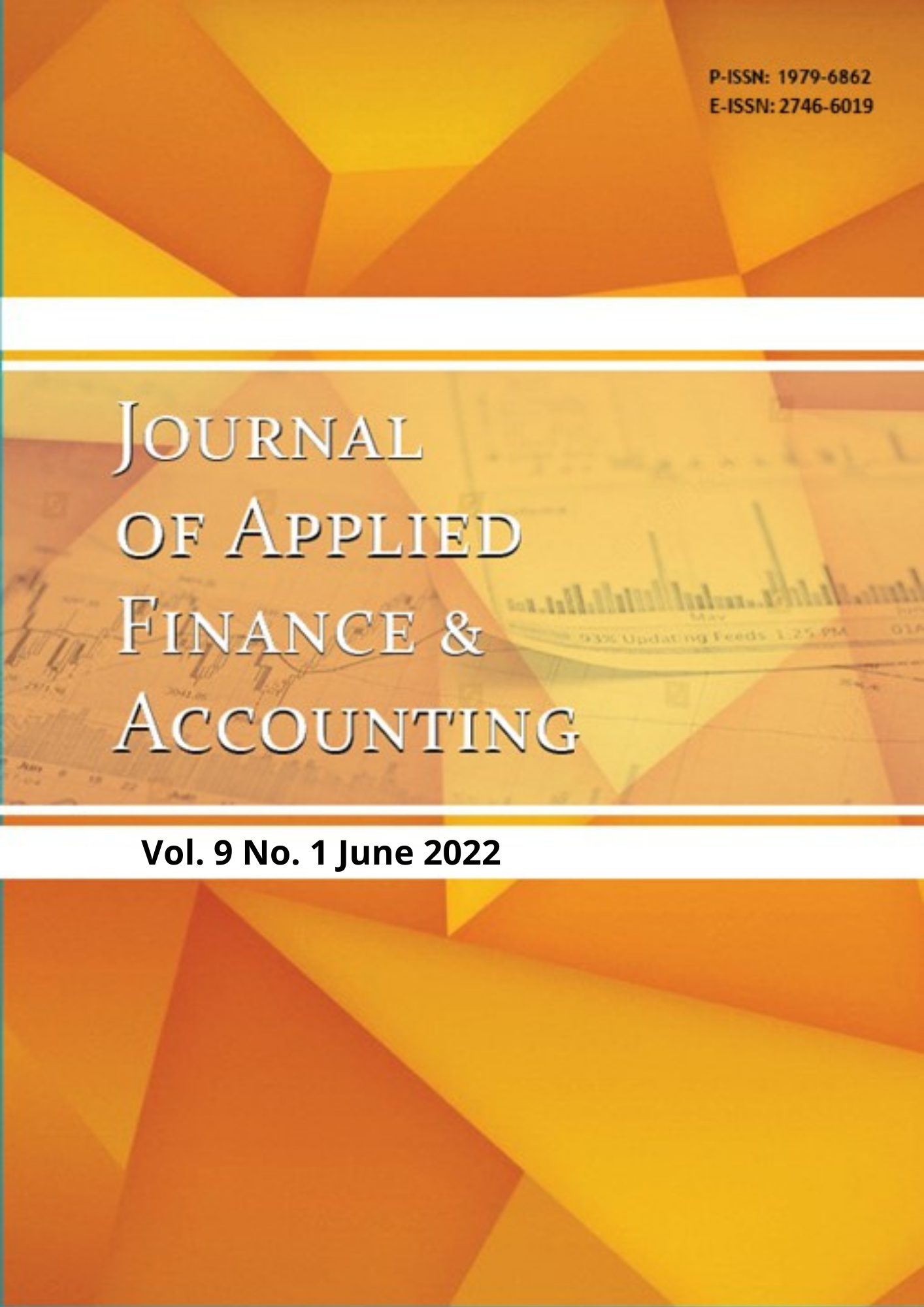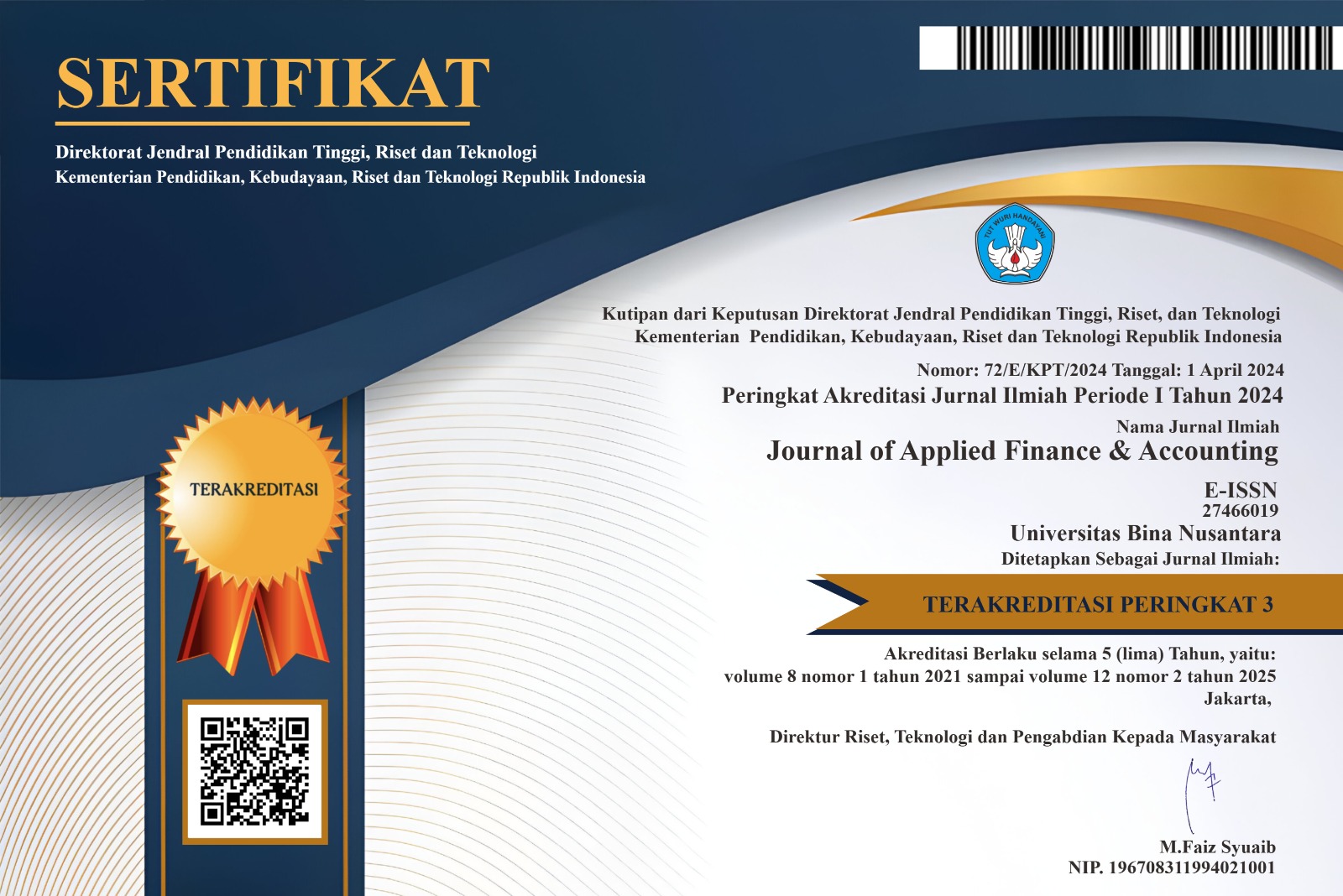THE EFFECT OF BEHAVIOR, TRUST, AND LITERACY ABOUT PEER TO PEER LENDING ON FINANCIAL INCLUSION IN THE JAKARTA COMMUNITY
DOI:
https://doi.org/10.21512/jafa.v9i1.8340Keywords:
Peer to Peer Lending, Behaviour, Trust, Literacy, Financial InclusionAbstract
This study aims to analyze the effect of behavior, trust, and literacy about peer to peer lending towards financial inclusion in Jakarta. This research uses SEM (Structural Equation Modeling) research method which is processed using PLS software. The sample used in this study were 150 respondents. The results showed that: (1) Behavior and literacy had a significant effect on financial inclusion. (2) Trust does not significantly effect on financial inclusion. It was concluded that the better public behavior in financial matters supported with the higher public literacy about peer to peer lending services had a positive influence on financial inclusion in Jakarta.
References
Ajzen, Icek. (1991). The theory of planned Behavior. Organizational Behavior and Human Decision Processes, 50: 179–211.
Hermawan, A., Yusran, H. L. (2017). Penelitian Bisnis Pendekatan Kuantitatif, (Jakarta: Kencana,2017), hal. 5-6
Badan Pusat Statistik Indonesia. www.bps.go.id. Jakarta. https://jakarta.bps.go.id/pressrelease/2019/07/15/358/persentase-penduduk-miskin-dki-jakarta-maret-2019-sebesar-3-47-persen.html
Corsini, Ray. (2002). The Dictionary of Psychology. London: Brunner/Rout Ledge.
Delon, A., and Evelyn. (2022). Pengaruh financial literacy dan demographic factors terhadap keputusan investasi P2P lending di masyarakat Surabaya. Prosiding HUBISINTEK, Vol. 2, No. 1.
Deni Danial Kesa. (2019). Realisai literasi keuangan masyarakat dan kearifan lokal: Studi kasus inklusi keuangan di desa Teluk Jambe. Jurnal Sosial Humaniora Terapan. 1(2), 34–43.
Hutabarat, F., and Purwanto, B (2018). Pengaruh literasi keuangan dan financial technology terhadap inklusi keuangan pada masyarakat jabodetabek. IPB University Scientific Repository, 1–55.
Ichwan, I., and Kasri, R. A. (2019). Why are youth intent on investing through Peer to Peer lending? Evidence from Indonesia. Journal of Islamic Monetary Economics and Finance, Vol. 5, No. 4.
Khan, M. T. I. (2022). Trust in peer-to-peer (P2P) lending platforms in Malaysia: Understanding the determinants from retail investors’ perspectives. Journal of Economic and Administrative Sciences, Vol. ahead-of-print No. ahead-of-print. https://doi.org/10.1108/JEAS-08-2021-0148.
Oh, Eun Young; Rosenkranz, Peter (2020) : Determinants of peer-to-peer lending expansion: The roles of financial development and financial literacy, ADB Economics Working Paper Series, No. 613, Asian Development Bank (ADB), Manila, https://doi.org/10.22617/WPS200107-2
OJK. Press release. (2017). OJK Announces Higher Financial Literacy and Inclusions Indices. Retrieved from: https://www.ojk.go.id/en/berita-dan-kegiatan/siaran-pers/Pages/Press-Release-OJK-Announces-Higher-Financial-Literacy-and-Inclusion-Indices-.aspx
OJK. Survei Nasional Literasi dan Inklusi Keuangan 2019. (2020). Retrieved from: https://www.ojk.go.id/id/berita-dan-kegiatan/publikasi/Pages/Survei-Nasional-Literasi-dan-Inklusi-Keuangan-2019.aspx
OJK Regulation (POJK) No. 77/POJK.01/2016 on Information Technology-Based Lending Services (LPMUBTI).
Pambudianti, F. F. R., Purwanto, B., and Maulana, T. N. A. (2020). The implementation of fintech: Efficiency of MSMEs loan distribution and users’ index of financial inclusion. Jurnal Keuangan dan Perbankan, 24(1), 68-82.
Peraturan Presiden Republik Indonesia Nomor 82 tahun 2016 tentang Strategi Nasional Keuangan Inklusif. Retrieved from: https://fiskal.kemenkeu.go.id/docs/inklusif/Perpres%2082%20Tahun%202016%20-%20Strategi%20Nasional%20Keuangan%20Inklusif.pdf
Putri, W. W., & Hamidi, M. (2019). Pengaruh literasi keuangan, efikasi keuangan, dan faktor demografi terhadap pengambilan keputusan investasi (Studi kasus pada mahasiswa magister manajemen fakultas ekonomi Universitas Andalas Padang). Jurnal Ilmiah Mahasiswa Ekonomi Manajemen, 4 (1), 398–412.
Seni, N.N.A., and Ratnadi, N. M. D. (2017). Theory of Planned Behavior Untuk Memprediksi Niat Berinvestasi.†E-Jurnal Ekonomi Dan Bisnis Universitas Udayana 12: 4043–68
Septiani, H. L. D., Sumarwan, U., Yuliati, L. N., and Kirbrandoko. (2020). Farmer’s behavioral intention to adopt Peer-to-peer lending using UTAUT2 approach. Jurnal Manajeman & Agribisnis, Vol. 17. No. 2.
Sugiyono. 2017. Metode Penelitian Kuantitatif, Kualitatif dan R&D. Bandung: Alfabeta.
Sunardi, R. and Purwana, D. (2021). Examining the factors contributing to Fin-tech Peer-to-peer lending adoption. Journal of Information Systems Engineering and Business Intelligence, Vol. 7, No. 2.
Suyanto, T. A. K. (2019). Faktor yang mempengaruhi tingkat kepercayaan penggunaan FinTech pada UMKM dengan menggunakan Technology Acceptance Model (TAM). Jurnal Akutansi & Manajemen Akmenika, 16(1), 175–186.
https://journal.upy.ac.id/index.php/akmenika/article/view/166
Very, C., and Panjaitan, Y. (2021). Pengaruh faktor perceived benefit, perceived ease of use, trust, dan financial literacy terhadap willingness to lend P2P lending. Prodising Woking Papers Series In Management, Vol. 13, No. 2.
Downloads
Published
Issue
Section
License
Authors who publish with this journal agree to the following terms:
Authors retain copyright and grant the journal right of first publication with the work simultaneously licensed under a Creative Commons Attribution License that allows others to share the work with an acknowledgement of the work's authorship and initial publication in this journal.
Authors are able to enter into separate, additional contractual arrangements for the non-exclusive distribution of the journal's published version of the work (e.g., post it to an institutional repository or publish it in a book), with an acknowledgement of its initial publication in this journal.
Authors are permitted and encouraged to post their work online (e.g., in institutional repositories or on their website) prior to and during the submission process, as it can lead to productive exchanges, as well as earlier and greater citation of published work (See The Effect of Open Access).





